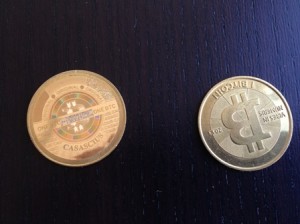I lived on Bitcoin for a week in 2013 – Day 1 / Day 2 / Day 3 / Day 4 / Day 5 / Day 6 / Day 7 – and learned a lot.
This year, I repeated my experiment — Day 1 / Day 2 / Day 3 / Day 4 / Day 5 / Day 6 / Day 7. Here’s what I learned this time:
1.It is easier to live on Bitcoin this year than last. I did “Living on Bitcoin: Part Deux” because every time I talked about living on Bitcoin for a week in 2013, people would ask if it would be easier now. I got sick of saying, “I think so.” Now I know that the answer is, “Yes.” Last year, I had to bike or walk anywhere I wanted to go, lost 5 pounds, moved out of my home, and constantly felt like a crazy person for asking people if they would accept payment in a made-up currency they’d never heard of. This year, I ate a 17-course dinner, went on a wine tour in Santa Cruz, and was able to use a ride-sharing service for all my trips, though I couldn’t buy gas when I drove myself. More people are familiar with merchants and more merchants accept it. Most importantly for me, payment intermediaries such as Gyft and Foodler accept it, giving me access to the services of the retailers and restaurants they’ve partnered with. And there will only be more merchants, with eBay being the latest to say they are considering it.
There were more places to spend my digital tokens this time. Note: No, these are not what ‘bitcoins’ are. These are just novelty tokens on which Bitcoin code is printed.
2. Bitcoin has infiltrated the mainstream consciousness. It’s definitely got the media captured. There’s a Wall Street Journal BitBeat blog devoted to it. Bloomberg put it on its terminals for traders and Bloomberg BusinessWeek put it on the cover of their magazine (as a unicorn). Newsweek put it on their cover in an unmasking of its mysterious creator Satoshi Nakamoto gone awry. Bitcoin has its own magazine created by its supporters and its own news service started by investor Shakhil Khan. Google search trends shows rising interest, especially when Bitcoin’s price has spiked, with the most interest in December 2013 when Bitcoin, worth mere pennies a four years earlier, surpassed $1000 a coin. According to a recent survey from The Street and research firm GfK, 75% of people still don’t know what Bitcoin is and 80% wouldn’t consider using it. Anecdotally, in the Bay Area this week, I’d say at least 75% had heard of it, though many were skeptical about using it.

Bitcoin magazine covers
3. I used to feel crazy when I asked people if I could pay for things in a made-up virtual currency, but now that Bitcoin is more widely known, I just feel eccentric.
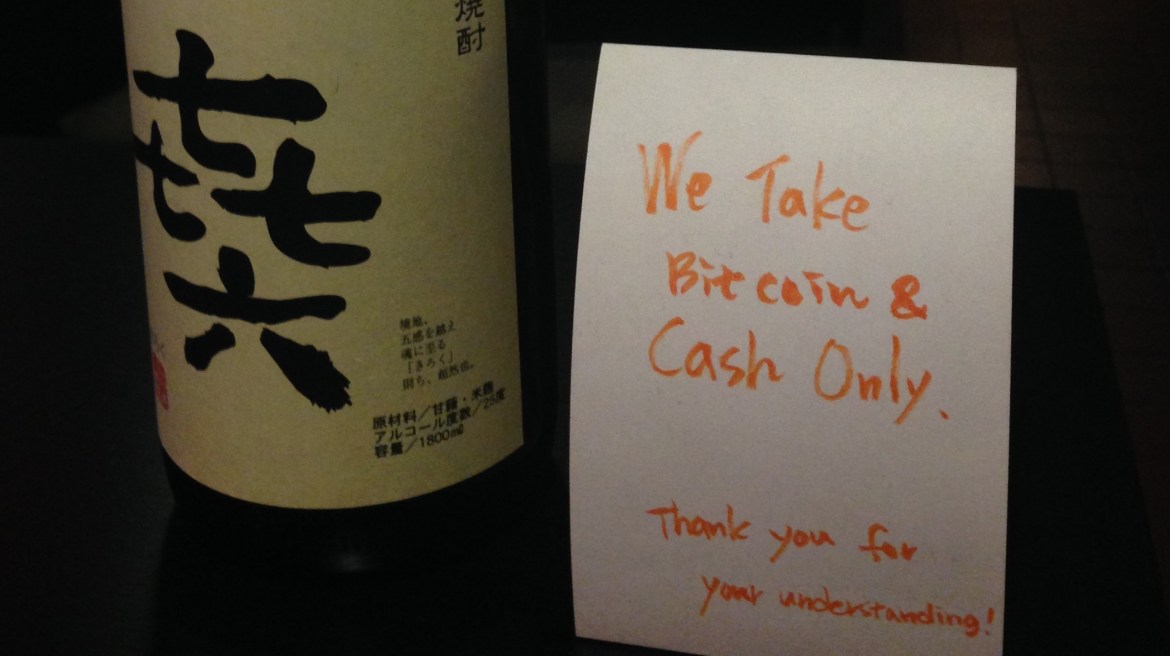
My kind of restaurant this week.
4. People may have heard of Bitcoin but they still don’t understand how it works. In my interactions with Lyft drivers, vintners, friends, strippers and coffee shop clerks, I found that many people knew of Bitcoin but they wanted to know how it worked. “It’s a giant public ledger maintained by a network of people running the Bitcoin program on their computers around the globe, decrypting and encrypting Bitcoin transactions broadcast to the network, who in exchange get ‘mining fees’ and Bitcoin payouts at a regular but decreasing-over-time rate,” I’d say. “It’s the online equivalent of sending cash, in that you can send it online with no information attached, and once sent you can’t reverse the payment,” I’d add trying to simplify it. Sending Bitcoin is ridiculously fast, but using it in person is often slow, because you have to have a long conversation about the payment method you’re using.
5. The mechanics of Bitcoin are more complicated than many make it out to be. Proponents emphasize that a utility of Bitcoin is that there “are no fees” when you send a payment because it’s processed by the Bitcoin network rather than a bank or credit card intermediary that charges you. In fact, the network is an intermediary and involves a bunch of people spending significant money on power to run the machines that run the network. Right now, they get paid in the form of new Bitcoin entering the network at regular intervals. More than 12 million bitcoin have been created of 21 million total, an amount that will be reached next century. But they also charge a very tiny mining fee set by Bitcoin developers. It is currently .0001 Bitcoin, or 4 cents. Not including the mining fee when you send a transaction mimics what will happen to the Web with the elimination of net neutrality. The miners bump your request to the bottom of their queue and it will take longer to go through (which is what happened to me, I think, when I wasn’t able to buy lunch at Buyer’s Best Friend because it took the Bitcoin network 67 minutes to confirm my $26/.0832 BTC payment). Those fees will eventually go up, as argued by the Economist.
6. There are people running the Bitcoin network and making decisions about how Bitcoin works. Though we often talk about Bitcoin as a faceless, automated network, there are software engineers making decisions about the Bitcoin program and implementing changes to the code. The mining network votes on those changes. It’s not as institutionalized as the Federal Reserve but a loose structure of governance does exist. The lead developer for Bitcoin, Gavin Andresen — different spelling and no relation to Marc Andreessen, the venture capitalist pouring millions into Bitcoin start-ups — is also on the board of the “Bitcoin Foundation,” an organization that financially supports the Bitcoin network and advocates for it. It’s received nearly 6,000 Bitcoins in donations (which is nearly $3 million at current value). Things get messy when humans are involved.

Peter Anderson, a 16-year-old retired Bitcoin miner
7. People are arriving late to the Bitcoin gold rush. In the early days of the Bitcoin program, you could download the software to your computer, go to sleep and wake up the proud new owner of 50 new Bitcoin (worth less than a dollar then, but $22,000 now). It’s not so easy now, as the 16-year-old miner I met in Silicon Valley learned; he spent $1,000 to build a machine that could participate in the network and the power to run it, and earned .38 BTC or $200. You need more powerful machines to do more difficult cryptographic hashing and lots of mining companies have popped up to sell them to people. But there are many tales of woe, lawsuits, and some FTC complaints from people who tried to buy money-minting machines.
8. When things do go wrong in Bitcoin, it’s not clear who you turn to. The wonderful thing about Bitcoin is that it’s a stateless, decentralized currency. The bad thing about Bitcoin when things go wrong is that it’s a stateless, decentralized currency. Ask people who had their Bitcoin savings stashed with Mt. Gox. “Anything that makes the headlines and is shiny and new tends to get misused by people trying to separate people from their hard-earned money. New Bitcoin, old scams,” says Lori Schock, the director of the SEC’s Office of Investor Education and Advocacy. “The challenge of getting your money back is grossly understated for any investor who runs into problems with a virtual currency.”
9. For all its complications, Bitcoin is an incredibly easy way to instantly open a bank account. It makes creating a place to store value online easier than getting an email address. And it’s incredibly easy to use. You scan a QR code or plug in a Bitcoin address and send money instantly. That is an incredible innovation and is why people are so excited about Bitcoin. And it makes this easy for anyone with a computer or smartphone and an Internet connection, whether they’re in the a country without a good banking system or a financially disenfranchised teen. Like cash, Bitcoin does not discriminate. “The reason I was so excited over Bitcoin was because, as a 16 year old, I had trouble buying stuff on the internet since I didn’t qualify for credit cards or a Paypal yet,” said a (young) commenter on one of my posts. “I thought, and still think, that Bitcoin could fill that gap.”

The caffeinated grail: I finally bought a hot cup of coffee for Bitcoin.
10. Belief tastes like a cappuccino at Coupa Cafe. I said last year that “I won’t totally believe in Bitcoin until I can buy a fresh cup of coffee with it.” I got my cup of coffee this year, though I did have to drive 30 miles south for it. Living on Bitcoin means traveling to places and websites you wouldn’t usually visit.
11. Using Bitcoin in the real world isn’t the point of Bitcoin. My experiment is a lark — a good way to make Bitcoin tangible and to meet the people involved — but it’s not revelatory of Bitcoin’s innovation.Bitcoin is still better as an online payment method than an in-person one. ”Bitcoin is programmable money!” complained one Redditor frustrated with the emphasis on where Bitcoin can be spent rather than how it can be spent. Bitcoin makes micropayments possible, so that you could theoretically send someone 85 cents because you liked their tweet, or 10 cents to read an article online rather than having to be bombarded with ads. It makes it easy to pay someone you don’t know without exchanging a bunch of information about yourself. When you make a payment you don’t need to include your name, address, phone number, email address, etc. for fraud prevention purposes, because you can only spend Bitcoin you have, like cash. And yes, merchants take it cut down on the fees usually charged by credit card fees — though they are usually paying 1% to processors like Bitpay and Coinbase who charge a fee to turn Bitcoin into USD.
12. If you are living in Bitcoin in the “real world,” you need to think ahead and call ahead. Otherwise you may end up in a Kmart parking lot, low on gas, with no way to get more.

Sorry, sis.
13. Accepting Bitcoin as a merchant is a great way to get publicity but may not result in any actual Bitcoin business. I saw the Santa Cruz Experience — a wine tour company — cited in numerous articles about businesses in the travel industry that accept Bitcoin. It had been accepting Bitcoin for a year, but I was the first person to actually pay them in it.
14. It’s possible to run a business in only Bitcoin, with no bank account. Blockchain.info would scoff at my living on Bitcoin for a week; they run a whole business in Bitcoin, with 16 employees over 4 continents.
15. However, most Bitcoin-accepting merchants are instantly turning their Bitcoin into cash. Vinny Lingham of Gyft thinks it’s part of what’s depressing the value of Bitcoin, creating more sellers in the market than buyers.
16. For early ideological Bitcoin adopters, Bitcoin was their favorite indie band and they hate that it’s gone mainstream. They like that they’ve made so much money off of recognizing Bitcoin’s potential, but they hate the attempts to regulate it and make the Bitcoin ecosystem look so much like the traditional financial ecosystem with the equivalent of Bitcoin banks that take a cut of transactions.
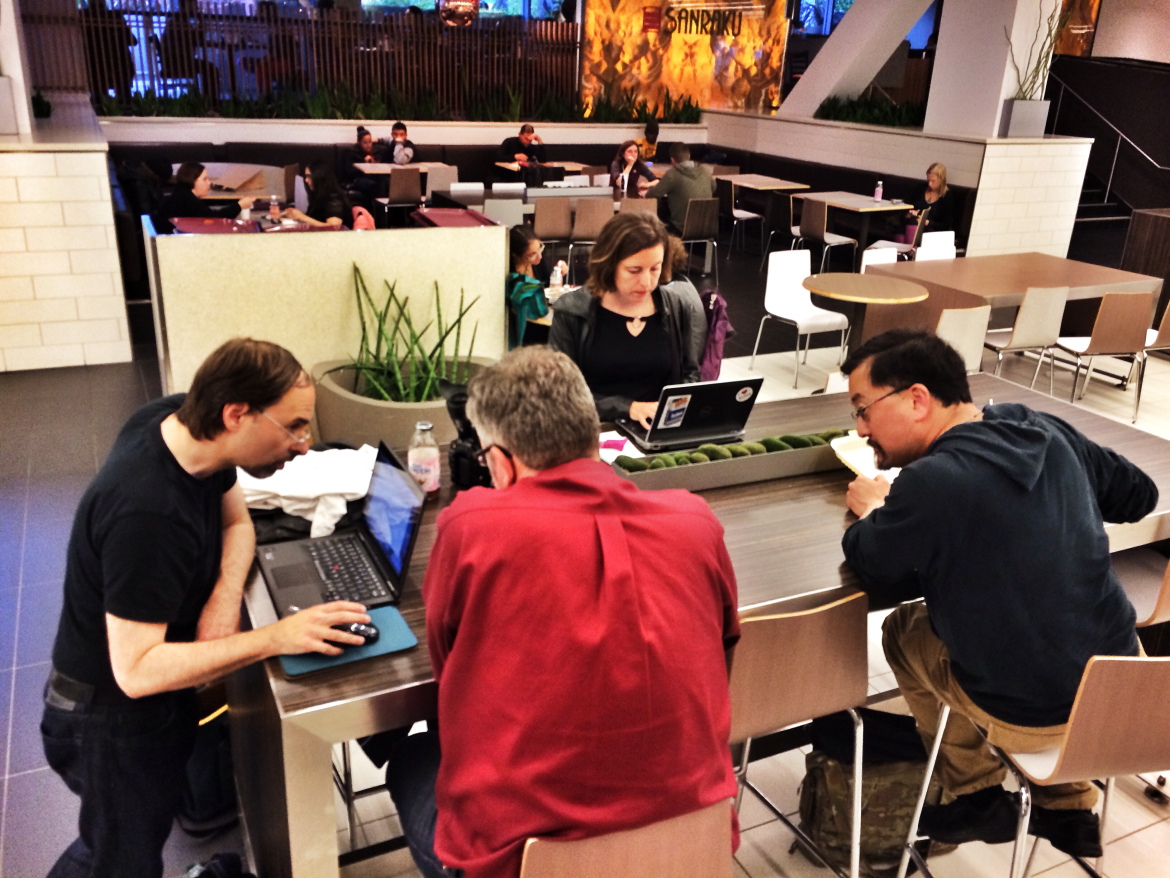
The early Bitcoin adopters still gather. A cryptocurrency trading meet-up in a movie theater food court.
17. A bitcoin dollar goes farther this year and I have more places to spend it. I spent nearly 5 bitcoin worth $600 last year during my week of living on Bitcoin in 2013. I spent 3.8 bitcoin worth $1,600 this week. And I will need to pay capital gains tax on the $1,000 of appreciation in those assets I spent.
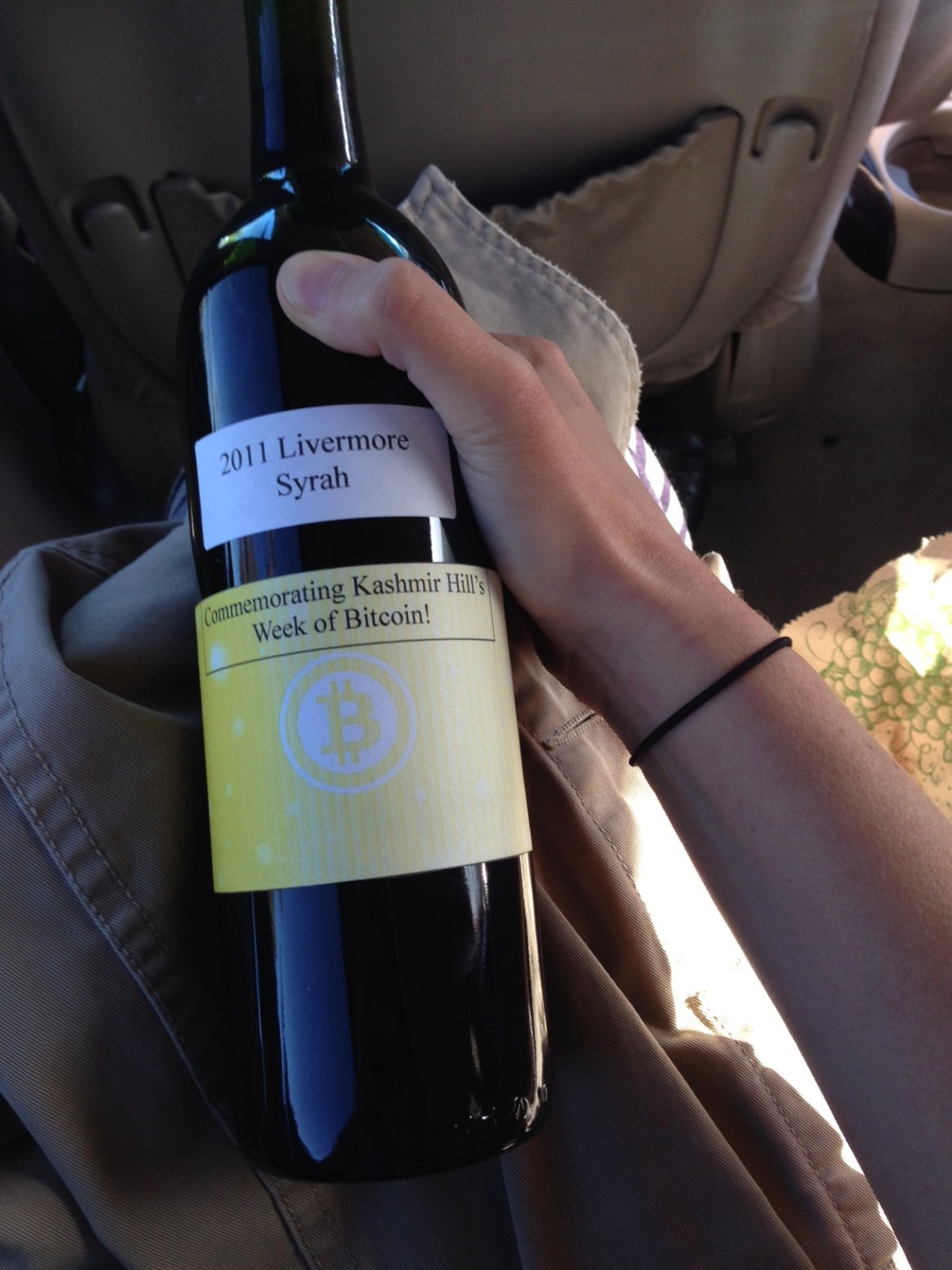
Living the good life on Bitcoin: A gift from the Santa Cruz Experience, after my BTC-paid wine tour
18. Bitcoin is an instant global currency. When I went to a strip club where I could pay in Bitcoin, a dancer told me she had been tipped in Japanese and Pakistani currency in the past and had no idea what it was worth until she went to a money exchanger to cash it in. The latter wasn’t even worth changing for dollars. With Bitcoin, you have a universal currency that could make traveling easier…. if more merchants were to accept it.
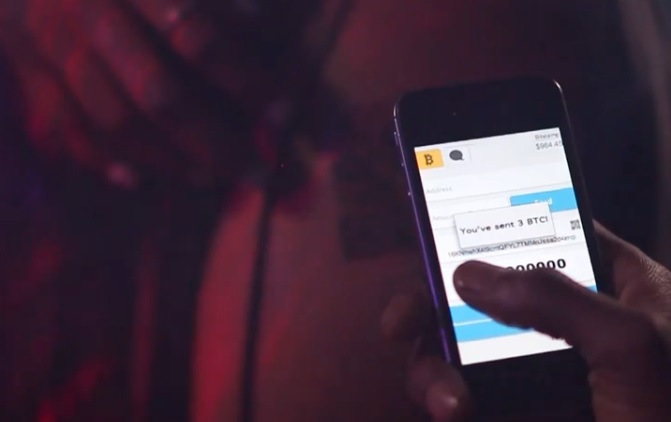
At least one rap video features an exotic dancer getting paid via QR code, via Zeroblock.
19. Bitcoin still scares governments. Bitcoin’s legality around the world is still a toss-up, which is part of the reason Apple won’t let Bitcoin-transmission apps in its store. China is doing its best to push Bitcoin out of its borders by shutting down and choking the businesses that exchange Bitcoin for Chinese currency. It is the greatest test of the stateless currency’s resilience. The U.S. is taking a different approach, embracing Bitcoin with regulation and taxation, perhaps killing it with government kindness.
20. The week is not as exciting as the year before. I spent less time on the fringes of society, and more time talking to entrepreneurs who have *made it* as their Bitcoin start-ups have taken off and attracted millions in venture capital. They are not quirky and rich like early Bitcoiners — such as the guy who told me he trades based on the alignment of the planets (13:44 mark) — just on their way to rich. Just this week, Bitpay announced that it received $30 million in venture capital from Virgin’s Richard Branson, founder of Yahoo Jerry Yang, and Asia’s richest man Li Ka-Shing of Hong Kong, who apparently doesn’t believe China can kill Bitcoin.

The “dark side” of Bitcoin doesn’t come up as often. When the government sent out a warning about Bitcoin this week, it was from the SEC and it contained a warning to people who have Bitcoin that they should be wary of fraudsters who seek to separate them from their now valuable money with high-risk investment schemes. No longer are U.S. lawmakers uniformly trying to crack down on Bitcoin, they are embracing it, with the Federal Election Committee approving Bitcoin for political donations (as long as the recipients immediately turn it into cash). Internet-savvy Democrat Jared Polis of Colorado immediately started accepting them. He’s immediately raised $1,500 from 39 donors, all donors I presume who included their names, addresses and occupation with their payments, per campaign rules, attaching their identities to at least one address on blockchain — making it more likely their identity can be tied to their other transactions.
21. There is a battle to keep the anonymous features of Bitcoin that first made it attractive as the currency for illicit marketplaces. There are people trying to sanitize Bitcoin who meet with people in Washington, D.C. regularly and there are people who still want it to be “a private means for black market transactions.” Right now, it feels like the sanitizers are winning, but the anonymity proponents have multiple projects in the works. From experience, I can tell you Dark Wallet is still pretty buggy, but Blockchain.info’s tumbler works like a charm.
I’m not sure if I’ll live on Bitcoin again next year or not. I’d love to hear whether you think I should in the comments. But if I do, I can see even more naked people. A nudist resort in Canada now takes Bitcoin because “a virtual currency is perfect for people without pockets!”
Provided from: Forbes.
